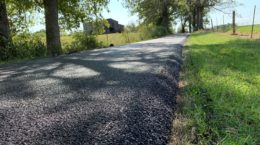There’s a new easy-to-use asphalt additive in town, and it is formulated to last!
Asphalt is the predominant paving material used today and has been for many years. For more than half a century, asphalt producers have attempted to modify the popular paving material in attempts to increase its durability and create longer lasting roads. While liquid asphalt modification additives have been tried and tested before, there is nothing on the market like BASF’s B2Last.
But what makes B2Last stand ahead of the pack? For that answer, we reached out to Brian Orr, senior asphalt technologist for BASF Corporation. Brian close to two decades of experience in the asphalt industry, including positions at Utah Department of Transportation (DOT), as well as technical leadership roles in asphalt binder laboratory management and asphalt terminal production and operations management.
Q: Why did BASF create B2Last?
Our global research and development and technical support teams are constantly on the look-out for ways we can use chemistry to solve many of the world’s challenges. With this mindset, we recognized the opportunity to bring a new chemistry to the asphalt industry that would increase terminal and construction company productivity while improving their overall experience in paving roads.
Q: What are some of the solutions that BASF is hoping to provide the asphalt world with B2Last?
Current processes for modifying asphalt are long, drawn out and sometimes take days before you can complete and ship product. B2Last is a liquid additive that can be injected into an asphalt binder tank using standard equipment. After injection and the reaction is given a few hours to complete, the liquid binder is ready to be used. It solves the issues of increased energy usage; and extended labor costs in an asphalt plant due to current lengthy modification processes. B2Last improves the asphalt binder in multiple ways and can also be used to reduce the number of modifiers used in asphalt formulations and simplify the modification of certain asphalt binders. It has also exhibited properties that show it helps with cracking resistance and the reduction of VOCs (volatile organic compounds) that off-gas during the paving process of asphalt.
Q: What makes this product different from other liquid asphalt additives in the marketplace?
- Although new to the asphalt industry, B2Last is based on a flexible universal chemistry that’s used throughout multiple industries in the world, from foam mattresses, to wood to tires, so it’s readily available.
- B2Last is a low-viscosity liquid that can be injected into liquid asphalt binders, so there are no solids to grind or melt into the binder resulting in less energy required to produce modified asphalt pavements.
- When B2Last is added to the asphalt binder it does not harm cracking resistance and can be formulated to provide extreme levels of modification.
- Finally, it’s an easy, sustainable approach to modifying binders that is readily adaptable to asphalt terminal and tank production operations.
Q: What kinds of binder modification benefits should the user expect with B2Last?
The main modification benefit we see is a bump in binder asphalt grade with minimal viscosity increases. As an example, if you started out with a PG64-22 performance graded asphalt, you could see from two, three, four or even five asphalt grade increases, where it could become a PG76-22, 82-22, 88-22 or 94-22 while maintaining workable viscosity.
Another benefit is that the minus 22 related to cracking resistance does not increase very much. It doesn’t harm that lower number while it significantly increases the upper end. There are some very moderate elastomeric properties that are given to the binder as well. We can see a stiffening that occurs and a recovery on the MSCR test. It has some EH&S benefits as well, related to off-gassing and VOC reduction.
Q: What is a reactive chemistry?
In the asphalt industry we typically think of asphalt modification as a blend, where we blend together Styrene-Butadiene-Styrene (SBS) and other modifiers to create a performance grade. The chemistry around B2Last is that it reacts within certain components within the asphalt to change the composition, such that, it is completely incorporated within the asphalt structure.
Q: Can you describe the potential energy savings to be gained from using B2Last?
Speaking from an asphalt binder terminal perspective, when you’re modifying liquid asphalt binder to meet certain performance grade specifications, you have to run an asphalt colloid mill. This is a massive power draw needed to grind down the SBS over the course of anywhere from 8 to 48 hours depending on what it is you’re making. This costs manpower, energy, and time. With the B2LAST additive, you do not need a mill. You simply need high enough agitation which would generally be a typical mixer that you would find in an asphalt tank. You simply inject the material over the course of an hour or two, allow it to sit and circulate in the same tank until the reaction completes. This reduces the energy use of the mill and any periphery parts that go along with it. It’s an exponential energy savings in an asphalt plant.
Q: How does it affect my terminal operations?
The only additional equipment is an injection port. Typically, asphalt plants already have injection ports for asphalt chemicals. These same ports would need cleaning before injecting the B2LAST through the same ports.
Q: Why hasn’t anyone worked with this area of chemistry before?
We’ve learned that companies have tried to use the chemistry that B2Last is based on in the past. But if you don’t work with these chemicals on a regular basis like we do, there are some nuances that may not be recognized. BASF has global expertise in this material in a significant variety of applications and industries.
Q: What EH&S issues are there around handling?
There are concerns from exposure that people could be sensitized to this material. However, if it is handled properly, reacted completely within the asphalt binder, and contained within the asphalt plant, there are no exposure issues or concerns. The material reacts completely, and it reduces any chance of exposure to close to zero. In the years and hundreds of hours we have been conducting research and development to adapt this arear of chemistry for asphalt applications, BASF and its research partners have had zero safety incidents or mishaps.
BASF Corporation is the largest affiliate of BASF SE and the second largest producer and marketer of chemicals and related products in North America.
To learn more about how B2Last can benefit your asphalt operations please visit the “Contact Us” section of the relevant B2Last website for your region.
For North, Central and South American inquiries please visit: https://b2lastna.basf.com.
For Europe, Asia-Pacific, and African inquiries please visit www.B2Last.com





